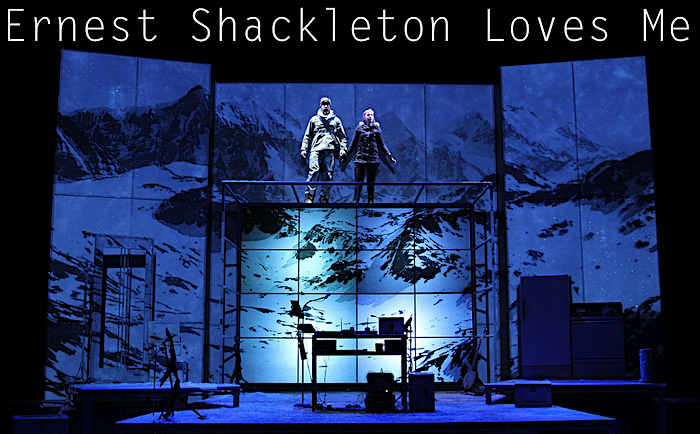Apologies as, per usual, by the time I get around to writing about all the theater I’ve seen in any given season, most of the shows are closed. But hopefully many of these will resurface regionally near you in the future. There are lots of gems in this batch.

 The Antipodes by Annie Baker (off-Broadway)
The Antipodes by Annie Baker (off-Broadway)
This was my third Annie Baker play (after The Flick and John in previous years) and, if I’m being honest, it’s my least favorite of the three. That being said, it’s still an Annie Baker play — she is one of our greatest modern playwrights and I will eagerly buy tickets to any of her creative offerings. (Did anyone see the NYT gushing over her co-written episode of Amazon’s I Love Dick? Whoever was smart enough to give her the keys to a TV series deserves high praise.) The Antipodes is set in a nondescript office space / writers’ room for something — perhaps a movie or TV series or video game, the specifics of which don’t really matter. The point is we see these writers (mostly white men — attention is drawn to how gender and race play out within the spectrum of writers’ rooms) bat around ideas, narratives, and personal stories in service of coming up with something real and original for this project. The unspecific nature of the setting lends itself to exploring big ideas about narrative. Time falls away over a series of take-out meals and costume changes for the assistant / receptionist. The play takes a supernatural turn when inexplicable things start happening. No grand conclusions are reached, but as usual Annie Baker’s explorations on a theme results in compelling dialogue, character revelations, and a measured pondering, all of which adds up to an engaging theatrical experience. I left the theater somewhat unsure about what I’d just seen and it took reading reviews to more fully cement my ideas about the show — and those opened me up to a greater appreciation for this play. To Annie Baker’s credit, The Antipodes had me thinking for several days.
 Oslo by J.T. Rogers (Broadway)
Oslo by J.T. Rogers (Broadway)
What a remarkable play. Rogers delves into a little-known diplomatic story about a Norwegian couple who helped negotiate a peace treaty between the Israeli and Palestinian governments in the early 1990s. Rogers met the real-life individuals upon which this a story based during his previous show at Lincoln Center and sussed out the dramatic story underneath these events, rendering them beautifully on stage. This story has dozens of twists and turns, and in less capable hands the play would’ve fallen apart. But director Bartlett Sher creates a visually compelling narrative in which the audience can easily navigate the intricate plot points — we are always clear what each character really wants under the surface, even when the might outwardly express different demands during these back-channel negotiations. The ease with which we follow this story is the result of brilliant theater artists collaborating at the highest level. It was not a surprise when this play won the Tony Award for Best Play last month. The show has since closed, but will certainty make its way around the country over the next few years.
 The Emperor Jones by Eugene O’Neill (off-Broadway)
The Emperor Jones by Eugene O’Neill (off-Broadway)
If you see more productions of The Emperor Jones pop up in recent months months, it is because this otherwise little-performed Eugene O’Neill play becomes quite relevant when a dictator-type is in power. We follow the story of Brutus Jones, a self-appointed dictator of a small Caribbean island (he is African American and was previously a porter in the U.S.) — at the beginning of the play, he receives word that his subjects intend to rebel against him and will arrive shortly to end his life. He scrambles into the woods before nightfall, attempting to find his way to a boat before the locals catch him. Much of the play takes place in the woods during his escape and O’Neill experiments with expressionism in the fogginess of Brutus’s experience. What follows is a pondering on the nature of ruling; here’s one quote that seems particularly relevant today: “Ain’t talking big what makes a man big, long as he makes folks believe it… I talk large when I ain’t got nothin’ to back it up.” Sound familiar? Fun story: I got a ticket for free when I approached the box office 10 minutes before the show began and they had a cancellation; the very kind person at the box office handed me the ticket. Praise be to the theater gods for that unexpected gift! Also worth noting: lead actor Obi Abili was a revelation in this role — he leaves it all on the stage. And in my quest to see every Eugene O’Neill plays, this was a new one for me and I’m grateful to add it to my canon.
 Pacific Overtures by Stephen Sondheim & John Weidman (off-Broadway)
Pacific Overtures by Stephen Sondheim & John Weidman (off-Broadway)
A new-to-me Sondheim musical — what a delicious treat! Pacific Overtures is about how Japan was forced to open up to the western world starting in 1853 when a boat from America arrives in Japan’s waters asking to meet with officials to discuss a possible trade agreement. Since foreigners are forbidden from walking on Japanese soil, the inventive decision is made to build a tea house on the shore where this meeting will take place, and afterwards they will burn the tea house. As decades pass and other cultures attempt to woo Japan into business, the country ultimately gives in to the increasingly interdependent ways of the world and rises into the technologically enterprising juggernaut we know Japan as today. John Doyle directs this stark and emotional production starring George Takei; it is presented as one act with a few numbers cut. I look forward to seeing another production in the future as Sondheim’s work can take multiple viewings / listenings to fully wrap one’s mind around the complexities of his lyrics. Grateful to finally be introduced to this show.
 Indecent by Paula Vogel
Indecent by Paula Vogel
Indecent is the kind of emotionally rich, complex play that you wish all Broadway shows operated on the level of. We follow a company of actors as they trace the origins of Polish-Jewish writer Sholem Asch’s play God of Vengeance, which features a lesbian love scene and was performed throughout Europe starting in 1907. Sixteen years later the play came to Broadway but its run was cut short when the cast was arrested following a performance for the indecent nature of the lesbian love scene. Indecent explores the impact of this play from its inception all the way through the Holocaust. It was written by Pulitzer winner Paula Vogel and marks her long-awaited Broadway debut; Tony winning director Rebecca Taichman also played a key role in developing the piece — she deserves credit for the show’s haunting visuals which will stay with me for a long time. On the outside, Indecent appears to be especially relevant to those belonging to the Jewish or queer communities. I’d posit that should be expanded to include anyone who believes theater is a vital art form. I’m reminded of the recent controversy surrounding The Public Theater’s production of Julius Caesar, in which its lead character intentionally resembled Trump — can you imagine if those actors were arrested on-stage for depicting what the alt-right might consider an “indecent” depiction of our current president? That is the modern day equivalent to what happened in 1923 with the play God of Vengeance. One would hope that such censorship is a thing of the past… but, as Indecent reminds us, we should not take such freedom of speech for granted. Lucky for all of us, Indecent has pulled a miracle by retracting its closing notice — it had been scheduled to shutter on June 25th following poor ticket sales, but will now run an additional six weeks, until August 6th. Get thee to the Cort Theater and see this remarkable play. (Side note: now I know how to spell “vengeance” properly.)

Cost of Living by Martyna Majok
After seeing Martyna Majok’s incredibly moving play Ironbound last year, I vowed to see as many of her new plays as possible going forward. Cost of Living features four actors, two of whom are disabled. And while their disabilities figure into the plot, they are wholly fleshed out characters who are just as nuanced and emotionally complicated as their able-bodied counterparts. In fact, they are downright unlikable at times, with a depth not typically bestowed upon disabled characters who are too often depicted as saints. The play trades off following two pairs of people (each comprised of a disabled and able-bodied person) as we learn more about their lives. The two threads of story merge near the end of the play in a way that feels somewhat contrived. We see the unfiltered reality of what the disabled characters must go through each day, including relying on the aid of their scene partners to shower. The two actors who play the disabled characters are quite accomplished — Katy Sullivan is a double amputee and Paraolympic record-setter in track. Gregg Mozgala has cerebral palsy with over a decade of acting experience on the NY stage. This play has just closed but if it resurfaces regionally in your neck of the woods, make it a point to get tickets.
 Miss Saigon by Claude-Michel Schonberg, Alain Boubil, & Richard Maltby Jr. (Broadway)
Miss Saigon by Claude-Michel Schonberg, Alain Boubil, & Richard Maltby Jr. (Broadway)
While I’ve loved the music of Miss Saigon for 20+ years, this is the first time I’ve seen it performed on stage. Let me begin by stating that this is a problematic show. It depicts the Vietnamese as victims of their own story, with very little agency as the Americans swoop in during the war to “save” them (failing miserably while taking advantage of local women and disrespecting Vietnamese culture). This American Theatre article spells it out quite plainly and is very worth a read. On a storytelling level, Miss Saigon is the least nuanced, most on-the-nose musical I’ve seen in awhile — the first 15 minutes I was especially taken aback at how plainly its misogyny was presented on-stage (yes, it’s depicting a different culture and time period, but that doesn’t preclude nuance). The other thing that hit me throughout the musical was how blatantly the show’s creators (Claude-Michel Schonberg and Alain Boubil) seemed to steal from their other hit, Les Mis — so many moments seemed wholesale translated from 19th century France to 20th century Vietnam. I guess if you have a successfully proven formula for historic musicals, you keep using it. So if you’re reading this, why should you see this show? If you love the music like I do, it is a treat to hear these songs presented with a lush orchestra and killer vocals. Tony-nominated lead Eva Noblezada is supposedly a revelation as Kim, but her understudy went on the night I attended. I was thrilled to see Jon Jon Briones as the Engineer — we both worked with the same musical theater group in LA about 10 years ago, and his career began with Miss Saigon back in 1989 as part of the ensemble when the show debuted in London, so he has a storied history with this piece. The sets of this current revival are top-notch. No expense is spared on the ensemble — its size is impressive. So if you can stomach the ignorant ways this show leans into cultural stereotypes and marginalizes a group of people, this revival of Miss Saigon is executed quite well from a staging standpoint. I was glad to finally see a production of it, as my knowledge up until now was merely based on listening to the original cast CD I borrowed from the local library in high school. If I could turn back time and see original star Lea Salonga and replacement Will Chase as Kim & Chris, I would do that in a heartbeat (check out footage of them performing on YouTube… you’re welcome).
 The Play That Goes Wrong by Henry Lewis, Jonathan Sayer, & Henry Shields (Broadway)
The Play That Goes Wrong by Henry Lewis, Jonathan Sayer, & Henry Shields (Broadway)
This is Noises Off on steroids — a behind-the-scenes murder mystery farce that goes entirely off the rails. Before the play even begins, the set begins breaking down (stagehands half-heartedly try to fix it, calling audience members on-stage to assist)… and by the end of the night there isn’t much of a set to speak of. Everything that can go wrong does go wrong, and it’s pretty hysterical each step of the way. My main spot of criticism: this show should be 90 minutes with no intermission. Full stop. The goofiness, no matter how funny, does not sustain a whole two hours. It’s too repetitive to return from intermission for more of the same shenanigans. That said, I still very much enjoyed my night here — especially the character who mispronounces words (e.g. “facade” is fuh-cade… that one still makes me chuckle), and a stage hand named Trevor who is so over his job (“did you actually PAY to be here?!” he goads the audience during intermission). It’s a clever diversion and will provide lots of laughs. The $30 balcony seats are a steal — I got mine at the box office shortly before the show started.
 Ernest Shackleton Loves Me by Joe DiPietro, Val Vigoda, & Brendan Milburn (off-Broadway)
Ernest Shackleton Loves Me by Joe DiPietro, Val Vigoda, & Brendan Milburn (off-Broadway)
A travel-related musical? Sign me up! (For those unaware, Ernest Shackleton was an Antarctic explorer.) This show is unlike anything I’ve seen before — while on a dating website, a modern-day woman named Kat is suddenly connected via video chat with the famous early 1900s explorer (she is a single mom to a young infant, and her sleep-deprived brain goes along with the unlikely premise). When Ernest’s expedition ship Endurance gets stuck in a frozen ice floe, Kat joins him to search for help as they row 350 miles away to the nearest land. A video component shows photos of this real-life rescue — a level of adventure that Kat has never known. This whimsical dalliance with a historical figure gives Kat insight into her present-day existence, and she returns to Brooklyn with much-needed confidence to move forward in her life. The songs are infused with energy. Kat is played by the composer Val Vigoda, who uses a looping device and an electric violin to add layers of sound. Ernest Shackleton Loves me is delightfully weird, and it works.
 The Little Foxes by Lillian Hellman (Broadway)
The Little Foxes by Lillian Hellman (Broadway)
I am so glad to now be familiar with Lillian Hellman’s nugget of a play — its well-drawn characters and smart twists had me watching with rapt attention for all three acts. Set in a southern town on a cotton plantation in 1900, The Little Foxes is a family drama about three adult siblings jostling for the better end of a business deal that would establish a lucrative cotton mill on the property. Brothers Benjamin and Oscar have been left money by their father (their sister Regina was not since at that time only sons were considered legal heirs) but they need another $75,000 to close the deal. Regina, sensing her moment to squeeze her brothers out of the deal and finally obtain the power she’s been quietly waiting for, makes her move. I’ll refrain from spoiling more here, as the plot is gripping and so well-constructed that you should see it for yourself. And I haven’t even gotten to the best part of this particular production — actors Laura Linney and Cynthia Nixon swap roles every other performance, switching between the conniving Regina and her timid sister-in-law, Birdie. The night I went, Cynthia Nixon went on as Regina and Laura Linney played Birdie — and both blew me away. (For what it’s worth, the NYT review suggest if you have to pick one, see the opposite — with Laura as Regina and Cynthia as Birdie, because then the actresses are playing against type and the performances are all the more compelling for it). I was thisclose to buying a second ticket to see them reverse roles. Lillian Hellman wrote the play in 1939, a time when female playwrights were rarely produced on Broadway. (For more on Hellman, check out this detailed portrait by The Interval, a fantastic site that features interviews with artists about the intersection of feminism and theater.) Hellman has written terrific lines, like this one: “I used to think you were all sugar water,” Regina snaps when her placid daughter finally shows some spine. This production closed on July 2nd but try to catch it regionally — it’s a popular play and I can’t believe it’s taken me this long to finally see it.
 The Government Inspector by Nikolai Gogol, adapted by Jeffrey Hatcher (off-Broadway)
The Government Inspector by Nikolai Gogol, adapted by Jeffrey Hatcher (off-Broadway)
This satirical play was originally published in 1836, but it could not be more timely — a low-level civil servant is passing through a small Russian village when the local mayor mistakenly believes him to be a government inspector there to spy on the town’s leaders and report back to the Czar. So he does what any corrupt official would do: shower the stranger with money, booze, and praise from all the local leaders (the hospital director, the judge, the school master, etc.) to ensure that this inspector will report favorably on the town and, perhaps, even recommend a promotion for the mayor. Since the civil servant is quite a simpleton himself (played fabulously by Michael Urie), he laps up the bribes and praise without any idea as to why his fortune has suddenly turned so favorable. It’s the blind leading the blind, and it’s deliciously funny to watch it all unfold, especially with talent like Michael McGrath and Mary Testa on stage. This Red Bull Theater production of The Government Inspector is farce at its finest. It has just transfered to New World Stages for an extended run. Don’t miss it!
 Sunset Boulevard by Andrew Lloyd Webber, Don Black, Christoper Hampton (Broadway)
Sunset Boulevard by Andrew Lloyd Webber, Don Black, Christoper Hampton (Broadway)
One thing I love about theater is its ephemeral nature — a show runs, and then it’s gone forever. So it’s not very often that one gets a second chance to see a theatrical production, like this revival of Sunset Boulevard with Glenn Close reprising her role of aging movie star Norma Desmond 23 years after the original production. Her advanced age this time around raises the dramatic stakes, as Norma Desmond is supposedly in her 50s (Close is now 70), so Norma’s bid to return to the movies truly feels like her final shot. When a young and financially strapped writer named Joe happens upon Norma’s Hollywood Hills compound by accident, she demands he stay and help her with a film she’s been writing. Over time — and between suicide attempts — she pressures him into a relationship. Joe is our narrator, contextualizing Hollywood and laying bare the glitzy world we’ve come to associate with its types. A few exciting things about this production: it’s got a 41-piece orchestra on-stage that makes Andrew Lloyd Webber’s gorgeous score sound even more epic. Director Lonny Price originally staged this as a limited concert run in London, so the set is more bare bones compared to its last Broadway run 23 years ago, yet still quite elegant. Norma’s costumes stand out as appropriately stunning. And those voices! Michael Xavier (Joe) is as much of a dream to listen to as he is to look at (that Speedo scene…). Grateful to finally see this show on stage, and for the rare second chance opportunity to see Glenn Close in the leading role.
 A Doll’s House, Part 2 by Lucas Hnath (Broadway)
A Doll’s House, Part 2 by Lucas Hnath (Broadway)
The audacity of playwright Lucas Hnath to write a play with this title! Can you imagine Our Town, Part 2 or Romeo and Juliet, Part 2? Fortunately, in this case, the play earns its title by keeping up with the standard set by the original work. A Doll’s House, Part 2 picks up 15 years after Nora made the extremely unorthodox (and highly controversial when this Ibsen drama was first presented in 1879) decision to leave her husband and young children to pursue her own freedom. We find out what she’s been up to in these last 15 years (she’s written books under a pseudonym) and why she’s returned (turns out Torvald never filed their divorce papers and now it’s a sticky situation for both of them). But the crux of the play are back-to-back-to-back long overdue conversations — reckonings, really — between Nora and the closest people from her former life. Especially memorable is the scene between Nora and her daughter, a 20-something who is — in Nora’s eyes — painfully status quo: she is about to get married, she doesn’t read books, and she seems blindly unaware of all the effort Nora has gone through to advance the progress of women for future generations. The incomparable Laurie Metcalf plays Nora and reaffirms her status as one of the best stage performers of our time. She mines Hnath’s play for unexpected humor, and then plunges the emotional depths of the play with equal dexterity. This play recently announced an extension through the end of the year.
 Six Degrees of Separation by John Guare (Broadway)
Six Degrees of Separation by John Guare (Broadway)
Revival of a 1990 play based on the idea that we are connected to everyone on earth by a maximum of six other people — from “the president of the United Stages to a gondolier in Venice… every person is a new door, opening up into other worlds.” Here is the play’s intriguing premise: an affluent Manhattan couple is at home when a young black man barges in with a stab wound — he’s just been mugged outside and recognized the building because he went to school (Harvard) with the couple’s children. After they help him clean up the wound, the young man offers to stay and make the couple dinner. Over the course of the evening he reveals that his father is Sidney Poitier. The couple is completely won over by his charm (he even helps them close a multi-million dollar business deal with a visiting investor), but by morning they realize is whole identity is a scam. The remaining two-thirds of the play explores the backstory of how this young man got into their lives, and ruminates on the ways we are all connected. And, like the rotating Kandinsky painting on display in the couple’s home, how there are two sides to everything. Allison Janney stars as the wife/mother Ouisa, and she is perfection on stage. Corey Hawkins is also stand-out as the young black man who makes a sudden appearance in this couple’s lives.
 Sojourner’s by Mfoniso Udofia (off-Broadway)
Sojourner’s by Mfoniso Udofia (off-Broadway)
This play and the next one listed below are parts one and two of an intended nine-part cycle by this up-and-coming Nigerian female playwright. I heard excellent things about these two works and caught the final day of performances, seeing them back-to-back with a meal break in between. Sojourner’s takes place in Texas in the 1970s as a Nigerian couple (an earnest Abasiama and her spirited but unreliable husband) has immigrated to the United States to attend university; their plan is to move back home once their studies are complete. Abasiama is also about to give birth to their first child. But things don’t go as planned — the husband is far less serious about his studies and may not graduate. Abasiama intends to become a doctor but to make ends meet works at a convenience store booth where she meets a chatty prostitute named Moxie, who is eager to trade in her tumultuous lifestyle for some stability. Moxie is one of the most memorable characters I’ve ever seen on-stage; she has a run-on monologue that is so perfectly executed by actress Lakisha Michelle May. We also meet Disciple Ufot, another Nigerian immigrant who helps Abasiama get to the hospital in time to deliver her baby. He is everything her unreliable husband is not. Soon, Abasiama is faced with major decisions about her and her newborn daughter’s future. This play is so well-drawn; it navigates subtle plot points fully supported by each character’s intentions and motivations.
 Her Portmanteau by Mfoniso Udofia (off-Broadway)
Her Portmanteau by Mfoniso Udofia (off-Broadway)
I returned from the meal break eager to see where this story picks up, about 30 years after the first part. I knew from the program that one actress from the previous play is also in this one — Chinasa Ogbuagu plays Abasiama in Sojourner’s, and in Her Portmanteau she plays one of her daughters — a nice connection between the two pieces, and one you might not realize without the aid of the program because the actress portrays each character with such a different energy. Her Portmanteau only has three characters in it — a mother and her two daughters. Without giving away how it all goes down, I think I’m safe to reveal that one of Abasiama’s daughters grew up back in Nigeria, and the one other grew up in the United States. Her Portmanteau (which is another word for ‘travel trunk’) explores the fraught reunion between mother / daughter, and sister / sister. How will each pair connect with each other when their lives have unfolded under such a different set of cultural and familial circumstances? How can they bridge the giant gaps of privilege and abandonment to find a path forward, together? While I enjoyed the complexity of Sojourner’s plot better than this second piece, Her Portmanteau extends a deeper emotional reach and by the curtain call I was choking back sobs. I am so grateful to be exposed to this new-to-me playwright and look forward to continuing this theatrical journey with future editions of this play cycle.
 Animal by Clare Lizzimore (off-Broadway)
Animal by Clare Lizzimore (off-Broadway)
For the first 75% of this play, I wasn’t even sure I liked it. And then an M. Night Shyamalan-worthy twist in the final 15 minutes reframes everything we’ve just seen in a new light, and I realized how brilliantly the playwright has set it all up. It was totally worth my second-guessing for most of the show. I won’t give anything away here because I have a feeling this play will be done regionally in the coming years, but here is a general and spoiler-free premise: a 30-ish woman (played by Rebecca Hall) is out of sorts. Something has happened, though it’s unclear what. She is out of work for now. She (reluctantly) sees a therapist at her husband’s urging. Home life is not idyllic — she and her husband live with his feeble mother who requires around-the-clock care, including burdens like feeding and changing her, which often fall on our main character. She resents her husband for this. Things move in this vein until suddenly everything changes and we realize nothing is as it seems. The ensuing revelations feel completely natural and double the impact of the play’s theme, hitting the audience in a much more powerful way than if the playwright had explored the matter in a traditional, straightforward way.
 Ghost Light by Third Rail
Ghost Light by Third Rail
This immersive theatrical experience takes place behind the scenes of a theater at Lincoln Center. Upon first blush the premise reminds me of 10 out of 12, Anne Washburn’s play that takes place during tech of a play, where the audience wears headsets to hear all the backstage chatter as the actors rehearse their technical cues. But Ghost Light is so much deeper and more immersive than that — audiences get a full range of perspectives from people who work in theater: the star, the usher, the props person, the playwright, even the janitor. And we get to participate, too, all night long — at one point I was in the wings, operating waves that moved back and forth as an actress on-stage rowed a boat; I took my cue from a light that turned on/off to indicate when the wave action needed to happen. Other times I held props as actors ran around getting ready for a scene. The star pulled me and three others into her dressing room, thanking us for coming to her show and had us run lines with her. I watched an usher stuff programs. One actor showed us the scrapbooks of his lines that have been cut over various plays, scraps of scripts that now lie in filing cabinets like a mausoleum for dead dialogue. Other parts are more movement-based, where the audience silently witnesses actors dance, sing, and perform. Those held my focus less, as they felt like filler, or less relevant compared to some of the other interactions / observations. There is a tightly choreographed sequence as everyone runs around just before a performance begins — we experience this from multiple angles, each time getting more of an understanding as to just how seamlessly the actors move from room to room. I LOVED going behind the scenes of a theater in which I’ve seen so many shows — breaking that fourth wall and getting to see what it all looks like backstage. I even recognized props from past Lincoln Center productions, like the hanging deer from How to Transcend a Happy Marriage, which recently closed — that was a nice Easter egg for frequent theater-goers. The whole evening (the show runs about 2:15 with no intermission) I kept trying to piece together the structure of the show, how they divided up the locations so that groups would not overlap, and how the actors had tracks that put them in certain places at certain times. It’s like a giant puzzle of time and space. And one thing I love about Third Rail shows — this is the first one of theirs I’ve seen, despite hearing lots about their previous shows like And Then She Fell and Grand Paradise — is that they take great care to plan unique, one-on-one experiences for their guests. It’s cliched to compare all immersive theater to the one that came “first” (in terms of commercial exposure), Sleep No More, but it can’t be helped. In this case, Sleep No More has maybe 30 actors for 300 audience members (those are ballpark numbers). But Third Rail uses about 20 actors for maybe 100 guests. That means that everyone will have more custom, special experiences. And while Sleep No More is truly “choose your own adventure” theater, Ghost Light is tightly structured and everyone has basically the same experiences, since they move the audience in small groups through most of the same set-ups. Personally I appreciate that, because I didn’t have to worry that I was missing something — with Sleep No More I felt hyper-vigilant about the timeline (even consulting a NYT piece that broke down where to go, minute-by-minute, to get the “most” (how is that even quantifiable?) out of the experience. For Ghost Light I could just go along for the ride and not have to make decisions about what to see next, confident it has all been curated for me. Ghost Light recently extended and while tickets are hard to come by, it’s worth the effort to seek them out. It’s a truly unique theatrical experience. I am so glad to finally witness the site-specific work of Third Rail.






